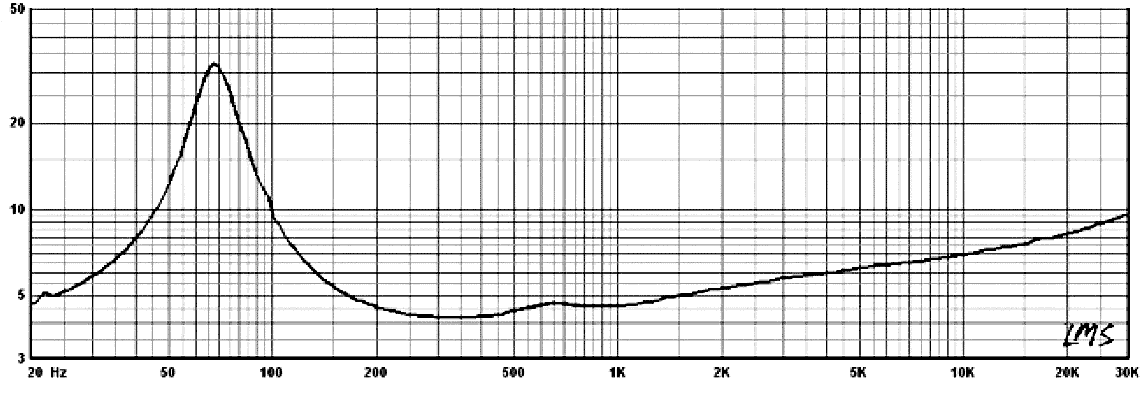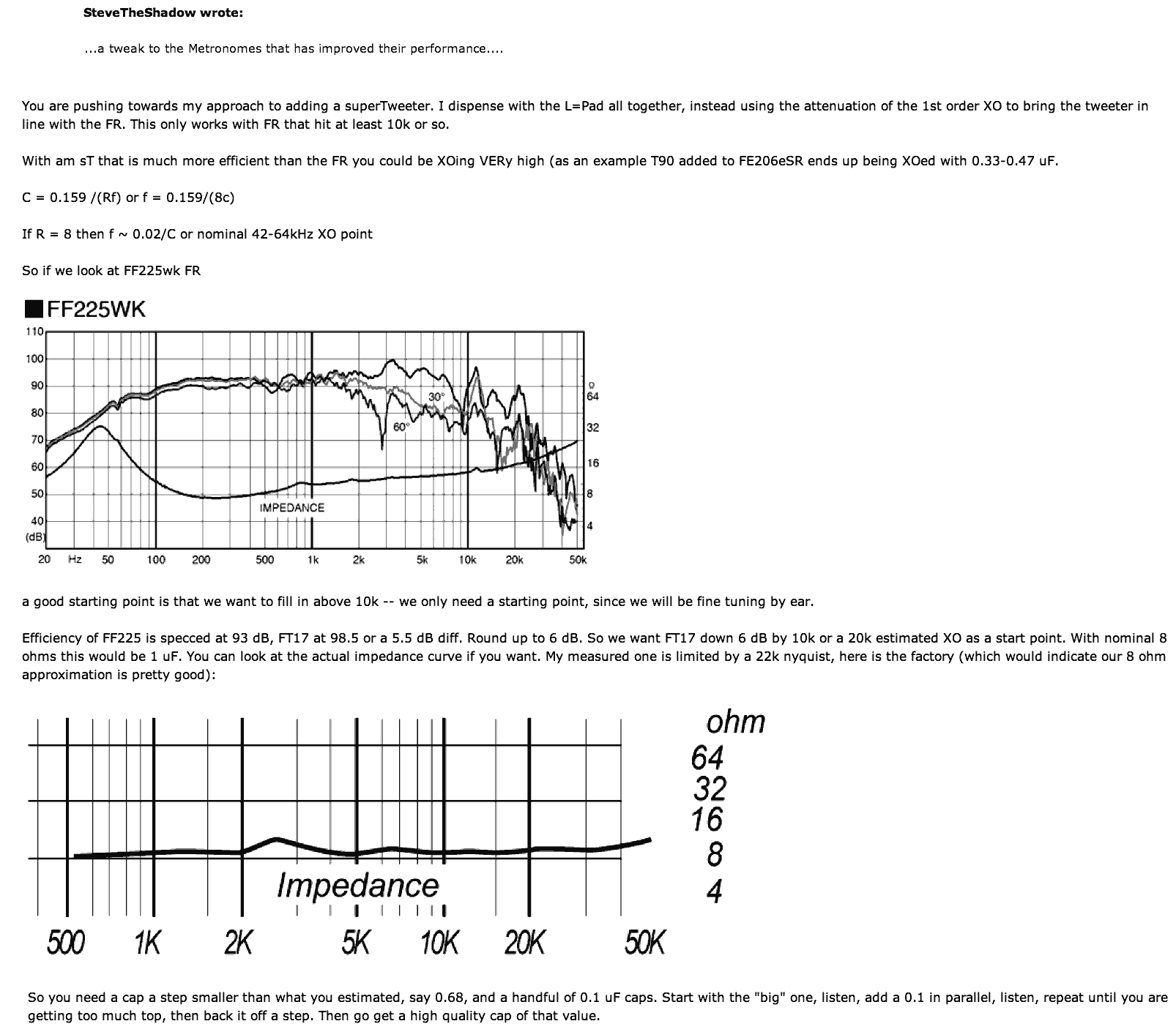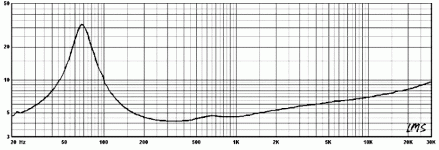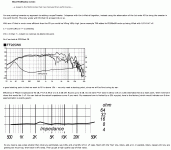I'm a little confused about adding a super tweeter to my full range speakers. I am driving my full range 4 ohm speakers with my LM4780 GainClone amp and want to add tweeters for those extra highs. Some of the commercial 'super tweeters' I have seen have built in crossovers and attenuators, but connect in parallel to the main driver. Surely if you don't have a crossover on the full range speaker, at certain frequencies the amp would 'see' a very low impedance as you have the full range driver and tweeter both being driven by the amp.
My LM4780 amp runs my 4 ohm speakers fine, but if I added an 8 ohm tweeter, at certain frequencies when the crossover allows the signal to the tweeter, the amp would see both speakers in parallel. 8 ohm and 4 ohm in parallel = 2.6ohms. I know the impedance of the speakers change at different frequencies, but is it safe to just add a tweeter crossed at say 6K Hz, or should I build a crossover for both?
My LM4780 amp runs my 4 ohm speakers fine, but if I added an 8 ohm tweeter, at certain frequencies when the crossover allows the signal to the tweeter, the amp would see both speakers in parallel. 8 ohm and 4 ohm in parallel = 2.6ohms. I know the impedance of the speakers change at different frequencies, but is it safe to just add a tweeter crossed at say 6K Hz, or should I build a crossover for both?
So the only low impedance seen by the amp will be at >6kHz where there probably isn't enough power drawn to damage the amp. Most of the power bandwidth will still see the 4 ohm full range speaker; remember that the tweeter crossover looks like a high impedance to low frequencies. Unless you have some really odd HF playback material (or I'm just plain wrong) you should be safe.I know the impedance of the speakers change at different frequencies,
I have to answer "it depends"
First, remember the full range impedance raises quickly at higher frequencies. All that copper in the voice coil you know. I am sure the OEM can provide you a plot that shows this. You did not describe your full ranges or if they have a Zobel or other compensation networks, as that can change everything. In other words, safety wise, I agree with sofa, you should be fine. But, you are not adding an 8 Ohm tweeter, but a variable impedance that does not dip too far below 8 with some crossover that may or may not raise the impedance. You are actually asking a very complicated question for us to be exact in our answer. Say, the tweeter has an L-pad on it. Now you ARE putting an 8 ohm load across the entire frequency range, unless the pad is inside the crossover. It depends.
Just adding a tweeter without a complete two way crossover only gives half the advantage the tweeter could provide and may be very difficult to integrate.
What? Yes. All drivers have breakup modes. Translation:distortion. A full range may actually "use" the breakup to give the impression of extended highs so you only need a little "air" on top. But, if you added a complete crossover, you can reduce that distortion and get the highs too while making the integration easier. Just adding the tweeter may give you ugly peaks where the full range is breaking up the worst causing difficulty in overall balance.
Now I know, the full range camp is very proud of not having nasty filters in the critical range to mess up their sound. I fully understand that argument. I offer the suggestion that crossing over above 5K with a not very steep crossover provides some help on the full range breakup and will be very easy on the tweeter and easier to integrate satisfactory.
Of course, now we will have moved you into the "wide range mid" multi-way camp.
First, remember the full range impedance raises quickly at higher frequencies. All that copper in the voice coil you know. I am sure the OEM can provide you a plot that shows this. You did not describe your full ranges or if they have a Zobel or other compensation networks, as that can change everything. In other words, safety wise, I agree with sofa, you should be fine. But, you are not adding an 8 Ohm tweeter, but a variable impedance that does not dip too far below 8 with some crossover that may or may not raise the impedance. You are actually asking a very complicated question for us to be exact in our answer. Say, the tweeter has an L-pad on it. Now you ARE putting an 8 ohm load across the entire frequency range, unless the pad is inside the crossover. It depends.
Just adding a tweeter without a complete two way crossover only gives half the advantage the tweeter could provide and may be very difficult to integrate.
What? Yes. All drivers have breakup modes. Translation:distortion. A full range may actually "use" the breakup to give the impression of extended highs so you only need a little "air" on top. But, if you added a complete crossover, you can reduce that distortion and get the highs too while making the integration easier. Just adding the tweeter may give you ugly peaks where the full range is breaking up the worst causing difficulty in overall balance.
Now I know, the full range camp is very proud of not having nasty filters in the critical range to mess up their sound. I fully understand that argument. I offer the suggestion that crossing over above 5K with a not very steep crossover provides some help on the full range breakup and will be very easy on the tweeter and easier to integrate satisfactory.
Of course, now we will have moved you into the "wide range mid" multi-way camp.
IIRC, you have CHP-70 in FH3?
Impedance of CHP:

The copper cap on the polepiece prevents the impedance from rising too high.
Now CHP70 is down about 6 dB at 13-14 KHz on axis.
Even if you XOed an 8 ohm tweeter (or a tweeter with an 8 ohm L-Pad) you would have impedance on the order of 4 ohms.
My prefered method of bringing in a super tweeter as high as is needed here is to just use a single cap & XO high enuff that the attenuation of the XO to bring tweeter level down to match the FR.
Here is a practical example snapped from a post on another forum.

What TVRGeek says about phasing & C-C is all true, but up here the ear/brain is pretty forgiving, and in practise it works pretty good.
A FR depends on controlled breakup to get extended response. When you get a driver where the breakup isn't as controlled as would be wished, you get some peakiness -- for instance the 7k peak on the stock FF125wk that drove TVRGeek bonkers in his only FR endeavour. If you look closely at the CHP's impedance curve you can see a bump at ~650 Hz -- this marks the transition between pistonic behavior and controlled breaakup (the holy grail of FR breakup has the cone effectively becoming smaller as frequency goes up)
dave
Impedance of CHP:
The copper cap on the polepiece prevents the impedance from rising too high.
Now CHP70 is down about 6 dB at 13-14 KHz on axis.
Even if you XOed an 8 ohm tweeter (or a tweeter with an 8 ohm L-Pad) you would have impedance on the order of 4 ohms.
My prefered method of bringing in a super tweeter as high as is needed here is to just use a single cap & XO high enuff that the attenuation of the XO to bring tweeter level down to match the FR.
Here is a practical example snapped from a post on another forum.
What TVRGeek says about phasing & C-C is all true, but up here the ear/brain is pretty forgiving, and in practise it works pretty good.
A full range may actually "use" the breakup to give the impression of extended highs so you only need a little "air" on top
A FR depends on controlled breakup to get extended response. When you get a driver where the breakup isn't as controlled as would be wished, you get some peakiness -- for instance the 7k peak on the stock FF125wk that drove TVRGeek bonkers in his only FR endeavour. If you look closely at the CHP's impedance curve you can see a bump at ~650 Hz -- this marks the transition between pistonic behavior and controlled breaakup (the holy grail of FR breakup has the cone effectively becoming smaller as frequency goes up)
dave
Attachments
Hi Dave. I have the EL70s, not CHP-70s, but good guess. Anyway, at 10KHz, the impedance of the EL70s is about 6 ohms and climbing, so I suppose a simple cap on the tweeter wouldn't stress the amp too much.
Using an online calculator, the cap size for 10KHz cross would be 1.98uF and to get the speaker attenuation matched with the an L-Pad would require 3.99 ohms series and 8.03 ohms parallel for a 6dB attenuation.
Would these values be a good starting point? I will probably end up building a crossover for the full range at some point.
Using an online calculator, the cap size for 10KHz cross would be 1.98uF and to get the speaker attenuation matched with the an L-Pad would require 3.99 ohms series and 8.03 ohms parallel for a 6dB attenuation.
Would these values be a good starting point? I will probably end up building a crossover for the full range at some point.
Also, I had a question about L-Pad attenuators if someone here could answer please:
http://www.diyaudio.com/forums/multi-way/226785-l-pad-attenuators.html
Sorry for all of the questions, but I've done a lot of amp building, but not much crossover or speaker design
http://www.diyaudio.com/forums/multi-way/226785-l-pad-attenuators.html
Sorry for all of the questions, but I've done a lot of amp building, but not much crossover or speaker design
You could also do a series crossover.
Please, on-line calculators will lead you far astray as they don't consider phase, offset, edge diffraction, baffle step, rooms , etc. Now you have hinted at the FR, maybe if you suggested which tweeters you were looking at and described your boxes some more targeted starting values could be offered.
PS.
Actually I did four projects with full ranges. I kept the little Foungteks I built for computer speakers. I stopped short of ordering some Mark's as I remain convinced I do a better job with crossovers than trying to make a single driver work well enough for my tastes and remaining hearing.
Please, on-line calculators will lead you far astray as they don't consider phase, offset, edge diffraction, baffle step, rooms , etc. Now you have hinted at the FR, maybe if you suggested which tweeters you were looking at and described your boxes some more targeted starting values could be offered.
PS.
Actually I did four projects with full ranges. I kept the little Foungteks I built for computer speakers. I stopped short of ordering some Mark's as I remain convinced I do a better job with crossovers than trying to make a single driver work well enough for my tastes and remaining hearing.
I would say yes, you could use a series resistor and a cap without blowing up the amp or driver. I will still advocate a complete crossover. You have not described your cabinet so we have no idea what kind of response you are actually getting due to baffle strep.
IMHO, Looking at their spec sheet, this may be a great driver at the price point, but I would spend a lot more money on the driver if it were my project. Might head over to ZAPH and read a bit about his testing. Your full ranges are much better than a $9 US. tweeter. You get a major improvement at $30 and again at $60. After that, you should be in the real high end and improvements are expensive for smaller and smaller returns.
I don't care for L-pads in my final designs. I use them for prototyping, then go to series resistors and recalculate the cap. Smaller cap, one less part. Everyone has their own preferences here. Resistors are cheap.
As a side note, I don't know CSS drivers, but their LD25X tweeter may be worth a serious look.
IMHO, Looking at their spec sheet, this may be a great driver at the price point, but I would spend a lot more money on the driver if it were my project. Might head over to ZAPH and read a bit about his testing. Your full ranges are much better than a $9 US. tweeter. You get a major improvement at $30 and again at $60. After that, you should be in the real high end and improvements are expensive for smaller and smaller returns.
I don't care for L-pads in my final designs. I use them for prototyping, then go to series resistors and recalculate the cap. Smaller cap, one less part. Everyone has their own preferences here. Resistors are cheap.
As a side note, I don't know CSS drivers, but their LD25X tweeter may be worth a serious look.
http://creativesound.ca/pdf/CSS-ERT26-data-260310.pdf
Hmmm.....
If that 6dB dip around 10KHz to 12KHz is for real its going
to be very difficult to bring it in at 10KHz as a supertweeter.
(Without the bump below getting very much in the way.)
How they can call that response flat is beyond me.
rgds, sreten.
Hmmm.....
If that 6dB dip around 10KHz to 12KHz is for real its going
to be very difficult to bring it in at 10KHz as a supertweeter.
(Without the bump below getting very much in the way.)
How they can call that response flat is beyond me.
rgds, sreten.
Using an online calculator, the cap size for 10KHz cross would be 1.98uF and to get the speaker attenuation matched with the an L-Pad would require 3.99 ohms series and 8.03 ohms parallel for a 6dB attenuation.
EL70 is sort of a CHP with 2 magnets (and a different spider i believe)
I'd not do it that way. With only a 1 uF cap you will also have 6 dB attenuation at 10k, which is probably XOing the tweeter too low. The method that puts the XO higher also means that on the low end, the tweeter has quite a bit higher impedance.
dave
Hi,
The best supertweeter candidate I can find is the Dayton ND20FB-4,
Flat to beyond 30KHz, and no impedance peak to worry about,
so simply attenuate with a series R and x/o with a cap using
the total series resistance to calculate the capacitor value.
If you later go for a proper x/o, its also good for a 3 to 4KHz x/o.
rgds, sreten.
The best supertweeter candidate I can find is the Dayton ND20FB-4,
An externally hosted image should be here but it was not working when we last tested it.
Flat to beyond 30KHz, and no impedance peak to worry about,
so simply attenuate with a series R and x/o with a cap using
the total series resistance to calculate the capacitor value.
If you later go for a proper x/o, its also good for a 3 to 4KHz x/o.
rgds, sreten.
So you mean, to leave the L pad as it is an put a 1uF cap in series?
Using a 1uF cap puts the crossover point at 20KHz, is that right?
Start with a 1uF capa nd ditch the L-Pad. It will provide the XO at 10k with 6dB of attentuation -- i think 1 uf is likely too big and that a 0.6 and a handful of 0.1 would be a better start.
The L-Pad seems to get used by people that can't get their head around the cap-only method.
dave
Hi,
The cap only method works with a high x/o point but may be too much for
young ears, for the rest of us it probably will be fine for a supertweeter.
Basically you just adjust the 1st order x/o point so the treble sounds
balanced, down if its not enough, up if its too much, and the range
of the adjustments depends on the drivers relative sensitivities.
I don't agree it works well with very high senstivity tweeters,
here you should also attenuate and play with the x/o point.
rgds, sreten.
The cap only method works with a high x/o point but may be too much for
young ears, for the rest of us it probably will be fine for a supertweeter.
Basically you just adjust the 1st order x/o point so the treble sounds
balanced, down if its not enough, up if its too much, and the range
of the adjustments depends on the drivers relative sensitivities.
I don't agree it works well with very high senstivity tweeters,
here you should also attenuate and play with the x/o point.
rgds, sreten.
I don't agree it works well with very high senstivity tweeters
Works very well with T900 & FE206eSR. Nominal XO point up around 50k.
dave
I think I see what your talking about know. Use a simple cap so the crossover point is a lot higher than you think you need (say 20KHz), and because the tweeters dB/w is higher than the main driver this will attenuate the signal from 20KHz and under, no need for an L-Pad, right?
Any thoughts on the Vifa XT25SC90-04
Any thoughts on the Vifa XT25SC90-04
- Status
- This old topic is closed. If you want to reopen this topic, contact a moderator using the "Report Post" button.
- Home
- Loudspeakers
- Multi-Way
- Adding a super tweeter to a full range

